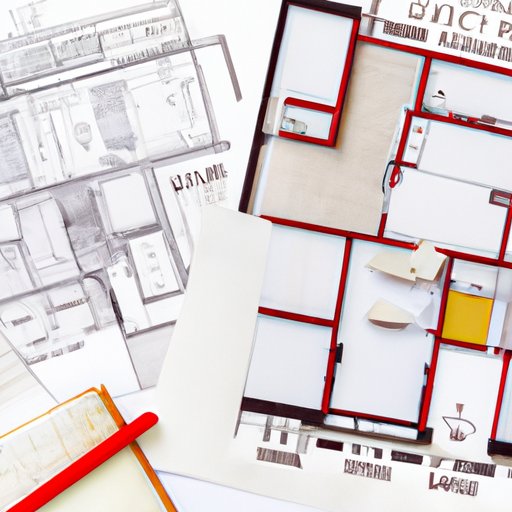
Introduction
Starting an interior design business can be a rewarding career choice for those who have a passion for aesthetics, creativity and working with people. Aspiring designers can gain the freedom of creating their own schedules, working with a variety of clients, and tapping into their artistic abilities daily. However, making this plans come to fruition requires a lot of upfront work and planning. In this article, we will provide a step-by-step guide to starting an interior design business along with practical tips, insights, and success stories from industry professionals.
Step-by-Step Guide
Before starting an interior design business, it is important to take the necessary time to evaluate the potential market, analyze competition, prepare a business plan, and begin networking.
Create a Business Plan: A business plan is essential for any startup and design business is not an exception. It helps to define the vision and mission of the company, the target customer audience, and the competition. A business plan also helps clarify the monetary investment required to start the business and keep it up and running.
Register Your Company: Registering your interior design company can be the next step. Depending on where you live or plan to practice, you may need to apply for different types of permits, registrations, or certifications. Consulting with a professional business consultant or lawyer may help you navigate this process more easily.
Get Licensed: The next step is to get earn your design credentials by obtaining a degree from an accredited institution. This can either be an undergraduate or advanced degree in interior design.
Get Business Insurance: It is important to purchase business insurance to protect yourself and your clients in the event of mistakes, accidents, or unforeseen issues. Your business plan can help you select which insurance policies are suitable for your company.
Create a Portfolio: Create a high-quality portfolio that showcases your work, skills, and experience. It is important to use your portfolio to help build your reputation and marketing your brand in the industry.
Start Marketing: Marketing your business will include creating social media profiles, reaching out to potential clients and affiliate businesses, networking and creating a website. Social media is not only an excellent way to exhibit your work but is also an excellent way to network and meet other professionals in the industry.
Interview with a Successful Interior Designer
We had the chance to interview a successful interior designer, Anna Phillips, who is the Founder and Design Director of Anna Phillips Interiors, a full-service interior design and decorating firm based in San Francisco.
Q: Can you explain some of the challenges you experienced when starting your design business?
Ana Phillips: One of the main challenges in the business was finding my niche. At the time I started my business, I was an interior design ‘generalist,’ and it took a while for me to realize that the greater opportunities lay in specializing in certain kinds of projects, such as custom homes, renovations, and transitional-style interiors. I was also challenged by building my brand and my portfolio while working on a tight budget.
Q: What is your advice for aspiring interior designers?
Ana Phillips: Be open to learning from others. Being curious and learning about the different aspects of design that pertain to client psychology, aesthetics, functionality, and current trends will help you better serve your clients.
Case Study
One good example of a successful interior design business is Studio McGee. This design company started as a small decorating blog in 2010 started by Syd and Shea McGee. Fast forward to 2021, Studio McGee has become one of the most successful interior design firms in the United States, with over 30 employees. This business got to be successful due to their market research, unique selling point, and investment in modern technology.
Studio McGee started with branding and building a strong online presence and social media presence to gain popularity and create brand connection with clients. By conducting extensive market research, Studio McGee discovered that there was a lack of affordable high-end interior design that people could trust. They began to offer that expertise online to their customers via their website.
The business invested in state-of-the-art technology and provided clients with the ability to visualize their spaces before the design work commenced. Additionally, they focused on providing excellent customer service by working with clients to find the best solutions for their homes.
Pros and Cons
Starting an interior design business has its advantages and disadvantages.
Advantages:
- Flexible working conditions
- Opportunity to work with diverse clients
- Opportunity to unleash your creativity and designing skills
- Potentially High Income
- You own your own business
Disadvantages:
- Highly competitive market
- High Start-Up Costs
- Long Hours, both physically and mentally demanding
- High risk of losing clients if not properly managed
- You have to juggle administrative work and design work
Top Tips Article
Here are some top tips for starting and running a successful interior design LLC:
- Start small and select a specialty
- Network with other designers, agents, contractors and furniture suppliers regularly
- Use modern technology to provide clients with exceptional services.
- Create social media accounts to showcase your work. Use Instagram, Facebook, and Pinterest to reach your potential clients.
- Create realistic budgets for your clients before taking on any project.
Conclusion
In conclusion, starting your interior design business requires time, planning, and dedication. With careful planning, branding, and quality services, interior designers will find that their talents and passions will propel their business forward. Follow the steps mentioned in the guide, learn from case stories, analyze the pros and cons of starting an interior design business and follow our top tips which will come in handy during your journey.





